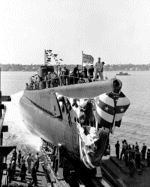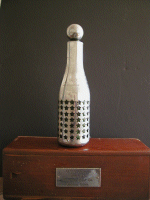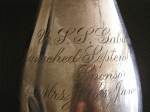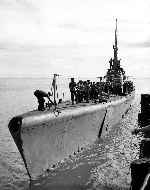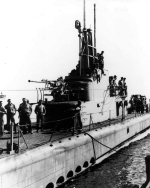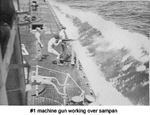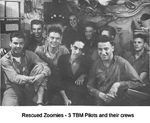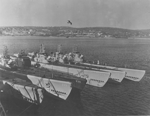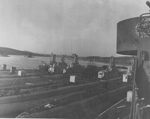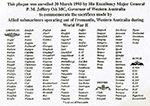Submarine Photo Index (original) (raw)
Click On Image
For Full Size
Size
Image Description
Source
36k
Commemorative post mark from Gabilan's (SS-252) keel laying 5 January 1943, at the Electric Boat Co., Groton, CT.
Photo courtesy of Jack Treutle (of blessed memory).
315k
Signs of the times: Logo's for the following boats are emblazoned on the building wall to the right: Dace (SS-247), Dorado (SS-248), Flasher (SS-249), Flier (SS-250), Flounder (SS-251) & Gabilan (SS-252).
Photo from the Photo Essay How To Build A Submarine at Electric Boat Co. New London, Conn.
Photographer: Bernard Hoffman, courtesy of life.time.com
519k
Gabilan (SS-252) was sponsored by Mrs. Jules James, wife of Rear Admiral James on 19 September 1943. From May 1943 to September 1945, James commanded the Sixth Naval District, headquartered at Charleston Navy Yard, Charleston, South Carolina.
They appear here in a Shipyard Newspaper "Produce to Win" article celebrating the keel laying of LSM-126 and LSM-127 on 29 January 1944, the first LSMs to be built at Charleston Navy Yard, Charleston, S.C.
Partial text courtesy of wikipedia.org,
US Navy Photo via Robert Hall.
76k
Gabilan (SS-252) slides down the launching ways, 19 September 1943.
USN photo courtesy of Electric Boat Co.
654k
Champagne bottle holder used by Mrs. Jules James, wife of Rear Admiral James, to christen Gabilan (SS-252) at the Electric Boat Co., Groton, CT., 19 September 1943.
Photo courtesy of Robert Hall.
684k
Close up view of champagne bottle holder used by Mrs. Jules James, wife of Rear Admiral James, to christen Gabilan (SS-252) at the Electric Boat Co., Groton, CT., 19 September 1943.
Photo courtesy of Robert Hall.
141k
Commemorative post mark from Gabilan's (SS-252) launching on 19 September 1943.
Photo courtesy of Scott Koen & ussnewyork.com.
21k
Commemorative post mark from Gabilan's (SS-252) commissioning, 28 December 1943.
Photo courtesy of Jack Treutle (of blessed memory).
198k
Gabilan (SS-252) torpedoes and sinks the Japanese minesweeper W-25 (492 tons) north-west of Zenizu, Japan in position 33^(o)51'N, 138^(o)35'E on 17 Jul 1944.
Photo of W-19 Class Minesweeper by Takeshi Yuki scanned from "Color Paintings of Japanese Warships" courtesy of combinedfleet.com.
Text courtesy of uboat.net.
144k
A sailor takes a line from the dock to secure the Gabilan's (SS-252) bow as the boat's crew prepare to come ashore, probably at Brisbane, Australia, 1944. Note the boat's mascot on the bow and the sailor holding a flag in his hand.
Victory and the end of the war meant the breaking up of most submarine crews. Garbo, Skeeter, Betty, and other dogs went home with crew members. Porches, lawns, and the occasional cat replaced steel hulls, tile decks, and depth charges. Gabby, mascot of the Gabilan, proudly represented all submarine sea dogs when he marched with his crew in a welcome-home victory parade in Mobile, Alabama, in October 1945.
USN photo courtesy of ussubvetsofwwii.org.
Pooch text courtesy of the article Sea Dogs by William Galvani in americanheritage.com.
168k
Officers and crew of the Gabilan (SS-252), prepare to come ashore, probably at Brisbane, Australia, 1944.
USN photo courtesy of ussubvetsofwwii.org.
122k
Gabilan's (SS-252) Number 1 Machine gun firing at an armed Sampan while on patrol.
USN photo courtesy of nuckolsarchive.adamsonarts.com.
116k
Gabilan's (SS-252) sixth and last war patrol (20 June-17 August 1945) was on lifeguard station for American fliers off Tokyo Bay. She first rescued six men, the crews of two torpedo bombers; then raced well inside Tokyo Bay, in easy range of shore batteries, to rescue another three-man crew. Six Navy "Hellcat" fighter planes gave her cover for the mission. On the way out, she paused to destroy a drifting mine with gunfire. Altogether, on this patrol Gabilan rescued 17 aviators.
Text courtesy of DANFS.
USN photo courtesy of nuckolsarchive.adamsonarts.com.
42k
Battle-flag of the Gabilan (SS-252), 1945.
USN photo courtesy of ussubvetsofwwii.org.
476k
Bow view of submarines post WW II at New London, Conn.
From inboard to outboard are six boats, four identified by hull numbers: Drum (SS-228), Halibut (SS-232), Haddo (SS-255) and Paddle (SS-263). Outboard of her are two numberless boats.
All the boats are decommissioned: none are flying colors or union jack. Date is after 16 February 1946 when Drum was decommissioned and before Halibut was sold for scrap on 10 January 1947. Halibut had suffered major damage by the Japanese and was considered beyond economical repair. She is the only one of the group not freshly painted, and has been stripped of deck guns and other gear, probably in preparation for sale.
The outboard boat has a small pennant flying from her jack-staff. The boats in commission popped up with numbers right away soon after VJ Day, so the outboard boats may just be getting painted up in Haze Grey in preparation for mothballing, with the numbers to follow. These two boats are older EB-built boats.
The inboard of the two numberless boats is likely the Gabilan (SS-252). It has a very distinct cut-down of the fairwater. Same bridge cut down low like most other Gato's but the sides of the wagon train were not cut out so it is solid, not open like most other Gato's that were cut down that low. Also location of SJ and SD radar antennas is the same as the latest pic of Gabilan. Also venturi looks the same. Gabilan was decommissioned in 1946 and laid up at New London which would match the timing and location.
USN photo & text courtesy of David Buell. Photo i.d. & text courtesy of John Hart.
380k
Stern view of submarines post WW II at New London, Conn.
From inboard to outboard is the reverse of the above.
USN photo & text courtesy of David Buell. Photo i.d. & text courtesy of John Hart.
365k
This plaque was unveiled 20 March 1995 by His Excellency Major General P.M. Jeffery OA MC, Governor of Western Australia to commemorate the sacrifices made by Allied submarines that operated out of Fremantle, Western Australia during WW II.
Photo courtesy of Ron Reeves (of blessed memory).


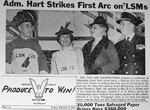 0825213
0825213